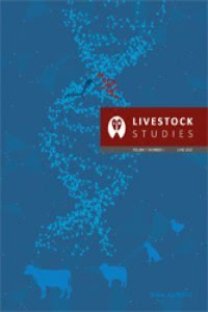7 GÜNLÜK İN-VİTRO SIĞIR EMBRİYOLARININ VİTRİFİKASYONLA DONDURULMASI
Bu çalışmanın amacı, in vitro olarak üretilen sığır embriyolarının, vitrifikasyon metodu ile dondurulma başarısının incelenmesidir. Mezbahada kesilen ineklerin ovaryumlarından elde edilen oositlerden üretilmiş 100 adet iyi kalite in-vitro sığır embriyosu, kültürlerinin yedinci gününde vitrifikasyon metodu ile dondurulmuştur. Vitrifikasyon solüsyonları olarak, VS1 (0.1 M Sakkaroz + 0.1 M Ksiloz + %1 Polietilen Glikol + %10 Gliserol), VS2 (0.2 M Sakkaroz + 0.2 M Ksiloz + %2 Polietilen Glikol + %10 Gliserol + %10 Etilen Glikol) ve VS3 (0.3 M Sakkaroz + 0.3 M Ksiloz + %3 Polietilen Glikol + %20 Gliserol + %20 Etilen Glikol) kullanılmıştır. Vitrifikasyon solüsyonları ile muamele edilen embriyolar payetler içine yerleştirildikten sonra sıvı azot içerisinde dondurulmuştur. Çözündürmede, sıvı azot içerisinden çıkarılan payetler 5-6 saniye havada tutulmuş, 200C’de suda tamamen çözündürülmüştür. Embriyolar kriyoprotektanların uzaklaştırılması (devitrifikasyon) işlemi için sırasıyla 0.5 M ve 0.25 M Sakkaroz solüsyonları içerisine alınmıştır. Sonra embriyolar morfolojik değerlendirme için %20 buzağı serumlu Dulbecco’nun Fosfat Tampon Solüsyonu (D-PBS) içerisine alınmıştır. Kültür medyumu olarak TCM-199 + 0,1mM β-Merkaptoetanol + %20 Fötal Buzağı Serumu (FCS) kullanılmıştır. İn vitro canlılık kontrolü amacıyla embriyolar, %5 CO2, %99 bağıl nem ve 38,50C‘deki inkubatörde 24-48 saat inkubasyona tabi tutulmuştur. Çözündürme sonrası PBS’e alınan 100 adet embriyonun, 85’inin intakt olduğu görülmüştür. Blastosistlerin re-ekspansiyon ve zonadan çıkma oranı %35 bulunmuştur. Buna göre in vitro üretilerek vitrifiye edilen sığır embriyolarında %35 canlılık tespit edilmiştir. İn vitro üretilen embriyolar vitrifikasyon metodu kullanılarak kolaylıkla dondurulmuş ve tatminkar düzeyde canlılık sağlanmıştır.
Anahtar Kelimeler:
Embriyo, sığır, vitrifikasyon, kriyoprotektan
The Vitrification of In Vitro Fertilized Bovine Embryos after 7 Days Cultured
The aim of the study was to investigate the effect of vitrification on in vitro produced bovine embryos. For this purpose, oocytes were provided from ovaries of slaughtered cows and 7 days after start of embryo culture 100 good quality in vitro produced bovine embryos were frozen by vitrification method. Vitrification solutions were composed as VS1 (0.1 M Sucrose + 0.1 M Xylose + 1% Poly Ethylene Glycol + 10% Glycerol), VS2 (0.2 M Sucrose + 0.2 M Xylose + 2% Poly Ethylene Glycol +10 % Glycerol + 10% Ethylene Glycol) and VS3 (0.3 M Sucrose + 0.3 M Xylose + 3% Poly Ethylene Glycol + 20% Glycerol + 20% Ethylene Glycol). The processed embryos with vitrification solutions were frozen in liquid nitrogen after placed into straws. The straws were thawed by holding in air for 5-6 sec and in 200C water. Embryos were transferred 0.5 M and 0.25 M sucrose solutions for devitrification procedure respectively. Then, the embryos were transferred into D-PBS (with 20% calf serum) for morfological evaluation. TCM-199 + 0.1mM β-Mercaptoethanol + 20% Foetal Calf Serum (FCS) composition was used as culture media. For in vitro survival control, embryos were incubated in the conditions with regard to 5% CO2, at 38.50C and 99% humidity for 24-48 hours. 85 intacted embryos were obtained from 100 embryos after thawing in Phospate Buffer Solution. The re-expansion and hatching rate of blastocysts were 35%. So, in vitro produced and vitrified bovine embryos survived with rate of 35%. As a result, in vitro produced embryos were frozen easily by vitrification method and provided satisfactory level for survival
Keywords:
Embryo, bovine, vitrification, cryoprotectant,
- Yayın Aralığı: Yılda 2 Sayı
- Başlangıç: 1959
- Yayıncı: Sezer ÖZ
Sayıdaki Diğer Makaleler
7 GÜNLÜK İN-VİTRO SIĞIR EMBRİYOLARININ VİTRİFİKASYONLA DONDURULMASI
Sedat Hamdi KIZIL, Numan AKYOL, Tahir KARAŞAHİN, Muharrem SATILMIŞ
KOÇ SPERMASININ KISA SÜRELİ SAKLANMASINDA ANTİOKSİDANLARIN ETKİSİ
Mustafa Numan BUCAK, Necmettin TEKİN, Recai KULAKSIZ
SÜT SIĞIRLARININ ISLAHINDA ÇEKİRDEK SÜRÜ - MOET TEKNİĞİNİN KULLANIMI (DERLEME)
Necmettin ÜNAL, Mehmet Nurullah ORMAN, Cemil ÇOLAK, Fatih ATASOY, Durhasan MUNDAN, Melik AYTAÇ
